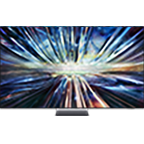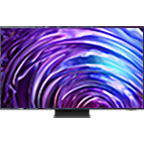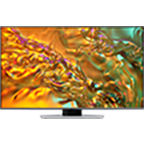Explore OLED
Filters
Filters
Elevate your entertainment with Samsung OLED TVs. Crafted for breathtaking visuals and immersive sound. Whether you're after a 4K Smart OLED TV or a spacious 65-inch display, Samsung delivers cutting-edge technology that transforms your viewing experience. Enjoy rich blacks, vibrant colours, and crystal-clear detail with our latest OLED 4K TVs.
All About OLED TVs
-
1. What Does OLED TV Mean?An OLED TV is a type of display that uses self-lighting pixels to create its image. Unlike traditional TVs that rely on a backlight, OLED panels use organic compounds that emit light when electricity is applied — hence the name OLED, which stands for Organic Light-Emitting Diode.
Each pixel in an OLED screen can be turned on and off, or have its brightness independently adjusted. This allows for incredibly precise control over contrast and color, resulting in deep, true blacks, vibrant visuals and ultra-responsive performance. Whether you're watching movies, gaming or streaming your favorite shows, OLED technology delivers a viewing experience that's hard to match. -
2. Are OLED TVs Worth It?Whether OLED TVs are worth it depends on your priorities and budget. Here are some factors to consider:
• Deep blacks and infinite contrast : Samsung OLED TVs deliver infinite contrast with true deep blacks, enhanced by Glare Free(S95F) anti-reflection tech and OLED HDR Pro/HDR+/HDR for balanced brightness and vivid visuals in any lighting. These features create a refined, immersive experience ideal for movies, dramas, and shadow-rich content.
•︎ Stunning Brightness: Samsung OLED TVs achieve high peak brightness for enhanced visibility in bright spaces and improved HDR performance, while self-emissive pixels ensure precise brightness control for deeper blacks and vibrant highlights. With OLED HDR Pro, the S95F delivers lifelike visuals with unmatched contrast and detail.
• ︎Vivid, lifelike colors : Samsung OLED TVs excel in producing rich, accurate colors through self-emissive technology, offering vivid hues and sharp details even in dark scenes. With Pantone Validated precision, they deliver lifelike visuals, ensuring creators’ intended colors are perfectly reproduced for an immersive experience.
•︎ Fast response times for smooth gaming : Samsung OLED TVs feature fast response times, high refresh rates (up to 165Hz), and gaming-specific technologies like Motion Xcelerator, ALLM, and AI Game Mode for smooth, lag-free gameplay. With G-Sync Compatible and FreeSync Premium Pro, they deliver tear-free, stutter-free visuals, making them ideal for immersive gaming.
•︎ Elegant, ultra-thin design : Without a bulky backlight, Samsung OLED TVs like the S95F feature ultra-thin designs, minimal bezels, and a matte finish for reduced glare, blending seamlessly into modern interiors as both a functional device and a stylish statement piece. -
3. What is the difference between OLED and QLED TVs?The primary differences between OLED and QLED TVs lie in their display technologies, picture quality, and design.
• OLED (Organic Light Emitting Diode):
Uses self-emissive pixels that produce their own light.
Each pixel can turn off completely, enabling deep blacks and infinite contrast.
•QLED (Quantum Dot Light Emitting Diode):
Uses a backlight combined with quantum dot technology to enhance color and brightness.
To learn more, check out our TV buying guide on What is OLED TV. It breaks down the differences between these types of TVs, and explains how these technologies work. -
4. What is the difference between OLED and Neo QLED TVs?The main differences between OLED and Neo QLED TVs lie in their display technologies, picture quality, and specific features. Here’s a detailed comparison:
Key Features
• OLED:
Deep blacks and infinite contrast.
Slim, elegant design. Fast response times for gaming.
• Neo QLED:
Uses a backlight composed of tiny mini-LEDs combined with quantum dot technology.
The mini-LEDs allow for finer control of brightness and contrast through local dimming zones.
Which Should You Choose?
Choose OLED if you prioritize deep blacks, contrast, and a sleek design, especially for dark room viewing or cinematic experiences.
Choose Neo QLED if you prefer brighter screens, improved contrast over traditional LED TVs, and affordability, particularly for well-lit rooms or larger sizes.
To learn more, check out our TV buying guide on What is OLED TV. It breaks down the differences between these types of TVs, and explains how these technologies work. -
5. Why Samsung OLED TVs Are an Outstanding Choice?As we’ve seen, OLED TVs — in particular ones designed by Samsung — stand out as a worthwhile investment for anyone seeking exceptional visual quality, innovative features, and sleek design. With their vibrant picture performance, advanced gaming capabilities, and smart energy-saving options like AI Energy Mode, they cater to a wide range of lifestyles and preferences. Whether you're passionate about movies, gaming, or modern aesthetics, Samsung OLED TVs offer a premium experience that truly justifies their value.
-
6. Which Samsung OLED TV should I buy?As we've seen above, Samsung OLED TVs are some of the best among OLED TVs, as they come equipped with various advanced technologies that make OLED TVs even more excellent.
But which Samsung OLED TV model you should choose in particular depends on your specific needs and preferences.
You can find the best TV to buy for your situation in just a few clicks through our Help Me Choose My TV guide. It lets you select various options like room, purpose, size and style — then brings you to the model that perfectly fits your choices. Whether it's a gaming TV or lifestyle TV, you can discover your ideal match here. -
7. How to reduce glare on Samsung OLED TVs?Glare occurs when light from windows, lamps, or other sources reflects off the TV screen, making it difficult to see the image clearly.
While they offer stunning picture quality, OLED TVs can be more prone to glare due to their glossy screens.
However, on Samsung OLED TVs, Glare Free, our proprietary anti-glare technology ensures that the image remains clear from distracting reflections. -
8. Is OLED worth it for console gaming?Yes, a Samsung OLED TV is an excellent choice for console gaming, especially if you value premium picture quality and advanced gaming features.
Here’s why Samsung OLED is worth considering for gaming.
1. Low Input Lag and Fast Response Time: Samsung OLED TVs are optimized for gaming with ultra-low input lag and fast response times, ensuring smooth and responsive gameplay.
2. Advanced Gaming Features: Samsung OLED TVs support HDMI 2.1, which enables features like 4K at 120 Hz (or higher) for ultra-smooth motion, Variable Refresh Rate (VRR) to eliminate screen tearing, Auto Low Latency Mode (ALLM) to automatically switch to gaming mode, and Nvidia G-Sync and FreeSync Premium Pro for enhanced compatibility with gaming consoles and PCs.
3. Stunning Visuals: Samsung OLED TVs are well-suited for immersive single-player games with deep blacks, vibrant colors and sharp details, thanks to Samsung OLED technology.
4. Wide Viewing Angles: Colors and contrast remain consistent even at extreme angles, making these TVs ideal for multiplayer setups or group gaming sessions.
5. Size Options: Samsung OLED TVs are available in a variety of sizes ranging from 55 inches to 83 inches. Smaller sizes (e.g. 55 inches) are ideal for compact spaces, while larger sizes (e.g. 83 inches) suit dedicated home theaters.
-
9. What is the largest OLED TV?Samsung’s OLED TV lineup includes 83-inch models, which are part of their premium offerings. If you’re looking for specific details about the 83-inch model, such as pricing or availability, please check Samsung’s official website or visit a retailer for the most accurate and up-to-date information.
* Key features may different from Key Spec.
* Images are for illustration purposes only and the accessories are sold separately.
* Features and specifications are subject to change without prior notification and may vary per country, please check in store for more details.
1. Certain features require express consent for the collection and use of personal information. Some features may require additional accessories (sold separately). Certain features, apps and services may not be available on all models and in all regions and are subject to change without notice. Internet connection required. Data, subscription or other charges may apply. Certain features are available only on free to air channels and/or require a Samsung Apps account.
2. Each speaker must be connected to a mains power supply. Wireless access to content requires a Wi-Fi network, compatible smart phone and Samsung Hub, sold separately. App must be downloaded. Data charges may apply. Usage may be subject to third party agreements. Samsung takes copyright seriously. Only share content that you own or have the right to share.
3. An NFC-enabled compatible device is required. NFC App may need to be downloaded.
4. To view in 3D, a 3D TV and 3D glasses are required.
5. Evolution Kit sold separately. It will enhance your smart features to the levels of the corresponding year of launch of your Evolution Kit. Only the software and processing hardware will be upgraded; other hardware will not be upgraded. Evolution Kit may not support certain apps and functions previously installed or available on your TV. Please check 117.p.syniva.es for more details before purchasing the Evolution Kit. Based on currently determinable UHD connectivity, broadcasting and Blu-Ray standardization initiatives. TV panel cannot be upgraded and may differ from future standards.
6. UHD Upscaling - Performance may vary depending on source content.





















